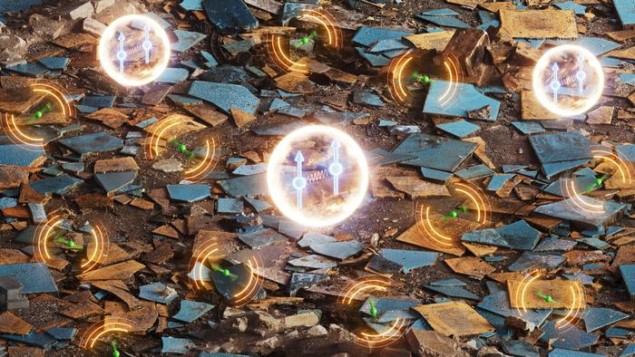
The length of time that quantum bits (qubits) retain their quantum nature is crucial for quantum computing because it determines the number and complexity of computations they can perform. For decades, the conventional wisdom has been that increasing this so-called coherence time meant protecting qubits from each other and from external perturbations. Now, however, researchers at Switzerland’s Paul Scherrer Institute, ETH Zurich and EPF Lausanne have turned this idea on its head by showing that some qubits can survive for longer periods in a noisy environment.
Like classical computers that store information in bits that have values of 0 or 1, quantum computing relies on systems that exist in two possible states. The difference is that qubits can also be in a superposition of these two states. It is this ambiguity that enables them to perform certain calculations much more quickly than classical machines, but quantum states are fragile and tend to decohere – meaning they revert to behaving like classical 0s and 1s, losing their precious quantum information.
In the latest work, researchers led by photonics scientist Gabriel Aeppli studied solid-state qubits made from terbium ions doped into crystals of yttrium lithium fluoride (YLiF4). These ions possess two low-lying quantum levels with an energy difference in the 5G communications frequency domain, and it is these two-state systems that the researchers used as their qubits. They found that while most of the qubits experience only average coherence times, the handful of qubits that form in pairs of terbium ions located close together turn out to be “exquisitely coherent”.
Sharp, distinct peaks
The researchers observed these unusually coherent qubits using microwave spectroscopy and spin echo probes, which are routinely employed to measure coherence times. They found very sharp, distinct peaks in their echo measurements, corresponding to much longer coherence times (100-fold longer in some cases) for the paired-ion qubits than for qubits located at average distances from their neighbours. The team explain these long coherence times by noting that the paired ions cannot exchange energy with nearby single ions and are thus not perturbed by interactions with them.
“The purpose of this research was to prove that it is possible to generate quantum coherent superpositions of crystal field levels (different low-energy organizations of the electrons on the rare-earth ions), even at rather high concentrations of the ions,” explains team member Markus Müller. “At first, it was not at all clear that we would be able to see any coherence in such a noisy environment and it was an unanticipated discovery that coherence was highly non-uniform among the doped entities and that ‘islands’ of high coherence can survive.”
The discovery could inform designs of quantum computing architectures, he adds – especially for schemes in which qubits are implanted randomly into a host matrix. Other potential applications include using the qubits as quantum sensors for magnetic dynamics in their environments. This might, for example, enable researchers to probe the speed of spin diffusion in random, dipolar coupled systems in studies of many-body localization and the role that dipolar interactions play in degrading it.
Optimizing the sensitivity of the pair qubits
Looking forward, the researchers aim to optimize the sensitivity of their pair qubits and to recreate quantum superpositions of local electro-nuclear states in host materials that are free of nuclear spin. Removing nuclear spin will minimize unwanted sources of magnetic noise, which in YLiF4 arise primarily from the fluorine atoms’ spin.

Charge qubits get a thousand-fold boost
“We will also try to achieve similar coherent superpositions of ion states of different angular momentum” Müller reveals. “These will extend the range of excitation frequencies from the microwave region (30 GHz) that we currently employ to the optical range, where the availability of strong lasers allows for faster excitation times (Rabi frequencies). Indeed, we have already obtained promising preliminary results in this direction.”
The team is also exploring ways of using pairs of dopants in the context of quantum information processing or computing with dopants in silicon.
The study is detailed in Nature Physics.
- SEO Powered Content & PR Distribution. Get Amplified Today.
- PlatoData.Network Vertical Generative Ai. Empower Yourself. Access Here.
- PlatoAiStream. Web3 Intelligence. Knowledge Amplified. Access Here.
- PlatoESG. Carbon, CleanTech, Energy, Environment, Solar, Waste Management. Access Here.
- PlatoHealth. Biotech and Clinical Trials Intelligence. Access Here.
- Source: https://physicsworld.com/a/long-lived-qubits-survive-as-islands-in-a-noisy-environment/



